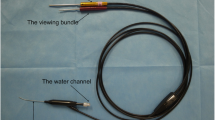Abstract
Background
Endoscopic dacryocystorhinostomy (e-DCR) is the mainstay for lacrimal sac/duct conditions. The purpose is to investigate the role of the exoscope as assisting tool in e-DCR.
Methods
Primary endpoint were symptoms resolution (epiphora/dacryocystitis) and time for surgery. Qualitative features of the exoscope were analyzed: a questionnaire administered to the surgical team allowed to evaluate the perceived quality of this technology.
Conclusions
The exoscope is a new tool that may support e-DCR. It has comparable results on symptoms outcomes and time for surgery than classic e-DCR. This new technology was accepted by all team members and showed great teaching potential.


Similar content being viewed by others
References
Wormald PJ (2002) Powered endoscopic dacryocystorhinostomy. Laryngoscope 112(1):69–72. https://doi.org/10.1097/00005537-200201000-00013
Muscatello L, Giudice M, Spriano G, Tondini L (2005) Endoscopic dacryocystorhinostomy: personal experience. Acta Otorhinolaryngol Ital 25:209–213
Huang J, Malek J, Chin D et al (2014) Systematic review and meta-analysis on outcomes for endoscopic versus external dacryocystorhinostomy. Orbit 33(2):81–90. https://doi.org/10.3109/01676830.2013.842253
Zenk J, Karatzanis AD, Psychogios G et al (2009) Long-term results of endonasal dacryocystorhinostomy. Eur Arch Otorhinolaryngol 266:1733–1738. https://doi.org/10.1007/s00405-009-1000-1
Lee KC (2008) Outcomes of posterior lacrimal sac approach in endoscopic dacryocystorhinostomy: review of 35 cases. Am J Rhinol 22(2):210–213. https://doi.org/10.2500/ajr.2008.22.3149
Wormald PJ, Sa FCS, Ed F et al (2000) Intranasal anatomy of the nasolacrimal sac in endoscopic dacryocystorhinostomy. Otolaryngol Head Neck Surg 123:307–310. https://doi.org/10.1067/mhn.2000.105416
Yakopson VS, Flanagan JC, Ahn D, Luo BP (2011) Dacryocystorhinostomy: history, evolution and future directions. Saudi J Ophthalmol 25(1):37–49. https://doi.org/10.1016/j.sjopt.2010.10.012
De Virgilio A, Iocca O, Di Maio P et al (2020) Free flap microvascular anastomosis in head and neck reconstruction using a 4K three-dimensional exoscope system (VITOM 3D). Int J Oral Maxillofac Surg. https://doi.org/10.1016/j.ijom.2020.01.022
Rossini Z, Cardia A, Milani D, Lasio GB, Angelo VD (2017) Video telescope operating monitor (VITOM) 3D: preliminary experience in cranial surgery. Technical case report. World Neurosurg 107:663–667. https://doi.org/10.1016/j.wneu.2017.08.083
Palumbo VD, Fazzotta S, Damiano G, Lo Monte AI (2018) VITOM® 3D system in surgeon microsurgical vascular training: our model and experience. J Vasc Access 19(1):108–109. https://doi.org/10.5301/jva.5000825
Funding
No financial support or benefits were received by any authors.
Author information
Authors and Affiliations
Corresponding author
Ethics declarations
Conflict of interest
The authors declare that they have no conflict of interest.
Ethical approval
Ethical approval was waived by the local Ethics Committee of Humanitas Clinical and Research Hospital in view of the retrospective nature of the study and all the procedures being performed were part of the routine care.
Informed consent
Informed consent was obtained from all individual participants included in the study and all of them signed informed consent regarding publishing their data and photographs. Additional informed consent was obtained from participant for whom possible identifying information is included in this article (Fig. 1). A copy of the consent form is available for review by the Editor of this journal.
Additional information
Publisher's Note
Springer Nature remains neutral with regard to jurisdictional claims in published maps and institutional affiliations.
Electronic supplementary material
Below is the link to the electronic supplementary material.
Supplementary file1 (MP4 10117 kb)
Rights and permissions
About this article
Cite this article
Pirola, F., Spriano, G. & Malvezzi, L. Preliminary experience with exoscope in lacrimal surgery. Eur Arch Otorhinolaryngol 278, 285–288 (2021). https://doi.org/10.1007/s00405-020-06379-9
Received:
Accepted:
Published:
Issue Date:
DOI: https://doi.org/10.1007/s00405-020-06379-9




